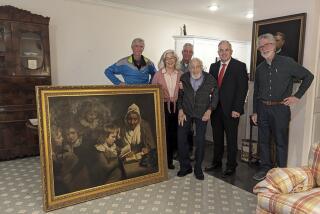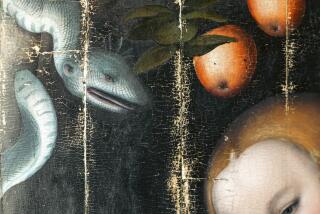Maybe it really was the perfect theft
GHENT, Belgium — Even though the painting has not been seen since 1934, it is becoming more popular by the day.
It is almost 70 years since the disappearance of a panel scarred one of Western art’s defining works. Now the theft of Jan Van Eyck’s “Just Judges” is taking on ever more mythic proportions.
The mystery only increased after a much publicized hunt for the highlight of Flemish primitive painting ended in disappointment last month when a secret cache in a northern Belgium church turned out to be empty.
“It is our monster of Loch Ness,” said Patrick Bernauw, who has written a book on the theft. “When it wasn’t found last month, the myth just reinforced itself a little bit more.”
The search captured front pages throughout Belgium and beyond, and the probe in the church was carried live on radio. Television broadcasts opened their news on location, and a Web site set up to highlight the discovery crashed under the weight of 75,000 hits a day.
For decades, a determined bunch of amateur detectives has picked up where police left off many years ago. For many, the concept is just too enticing: It unites a stupendous piece of art and a great detective story.
The 20-panel “Adoration of the Mystic Lamb,” completed in 1432, offers a translucent use of color created by layer upon layer of oils and mystical meaning. The “Just Judges” panel depicts 10 men on horseback on their way to venerate the Holy Lamb.
The panel was stolen along with a lesser panel on April 10, 1934, from St. Bavo Cathedral. Soon after, extortion letters sent to the bishop of Ghent demanded $25,000.
Any sleuth who could solve the crime would become an instant hero, a savior of a piece of national heritage.
Retired cabdriver Gaston De Roeck was convinced this summer that he would become that hero. He boldly proclaimed on his Web site that he knew where the “Just Judges” panel of Van Eyck’s “Adoration” was hidden.
Like so many before him, he had intimately studied the life of the presumed thief, Arsene Goedertier, who collapsed from a stroke seven months after the theft and uttered his last famous words: “Only I know where the ‘Adoration’ is.”
De Roeck dissected the 13 extortion letters for $25,000 in ransom, a huge sum at the time, which were sent to the local bishop’s office. The cabdriver decided the panel had to be hidden in the church of Goedertier’s hometown of Wetteren, just outside this Gothic city.
So De Roeck called in police on Oct. 4 to keep the curious at a safe distance. It only increased his disappointment when he came up empty-handed.
Meanwhile, up to 2,000 visitors a day go to the Gothic church in the center of town where Van Eyck’s “Adoration” is encased in 2 inches of reinforced glass to prevent another theft.
“Many come see the painting for something which is no longer there,” said author Bernauw. “That is almost art in itself.”
More to Read
The biggest entertainment stories
Get our big stories about Hollywood, film, television, music, arts, culture and more right in your inbox as soon as they publish.
You may occasionally receive promotional content from the Los Angeles Times.










